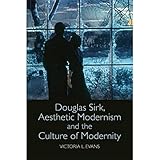Douglas Sirk, Aesthetic Modernism and the Culture of Modernity / Victoria L. Evans.
Material type: TextPublisher: Edinburgh : Edinburgh University Press, [2022]Copyright date: ©2017Description: 1 online resource (208 p.) : 12 B/W illustrationsContent type:
TextPublisher: Edinburgh : Edinburgh University Press, [2022]Copyright date: ©2017Description: 1 online resource (208 p.) : 12 B/W illustrationsContent type: - 9781474409391
- 9781474409407
- PN1998.3.S57 E93 2017
- PN1998.3.S57 E93 2017
- online - DeGruyter
| Item type | Current library | Call number | URL | Status | Notes | Barcode | |
|---|---|---|---|---|---|---|---|
 eBook
eBook
|
Biblioteca "Angelicum" Pont. Univ. S.Tommaso d'Aquino Nuvola online | online - DeGruyter (Browse shelf(Opens below)) | Online access | Not for loan (Accesso limitato) | Accesso per gli utenti autorizzati / Access for authorized users | (dgr)9781474409407 |
Frontmatter -- Contents -- Figures -- Acknowledgements -- Introduction -- Part One. Sirk and the Visual Arts -- CHAPTER ONE Thinking with the Heart: Sirk and Pictorial Reception -- CHAPTER TWO Concerning the Spiritual in Art: Magnificent Obsession and the Influence of Modernist Painting -- Part Two. The Shock of the New: Traces of Modernity -- CHAPTER THREE The Invasion of Machines and Machine Culture -- CHAPTER FOUR Imitation of Life and the Depiction of Suburban Space -- Part Three. Two Architectural Case Studies -- CHAPTER FIVE Final Chord and ‘Die Neue Welt’: The Mise-en-scène of Aufbruch -- CHAPTER SIX Back to the Future: Modernist Architecture and All That Heaven Allows -- Bibliography -- Index
restricted access online access with authorization star
http://purl.org/coar/access_right/c_16ec
Examines the influence of modernist art and architecture on the work of American director Douglas SirkThe first truly interdisciplinary analysis to link Douglas Sirk's striking visual aesthetic to key movements in twentieth century art and architecture, this book reveals how the exaggerated artifice of Sirk’s formal style emerged from his detailed understanding of the artistic debates that raged in 1920s Europe and the post-war United States. With detailed case studies of Final Chord and All That Heaven Allows, Victoria Evans demonstrates how Sirk attempted to dissolve the boundaries of cinema by assimilating elements of avant-garde art, architecture and design into the colour, composition and setting of many of his most well-known films. Treating Sirk’s oeuvre as a continuum between his German and American periods, Evans argues that his mise-en-scène was the result of an interdisciplinary, transnational dialogue, and illuminates the broader cultural context in which his films appeared by establishing links between archival documents, Modernist manifestos and the philosophical writings of his peers.
Mode of access: Internet via World Wide Web.
In English.
Description based on online resource; title from PDF title page (publisher's Web site, viewed 29. Jun 2022)


